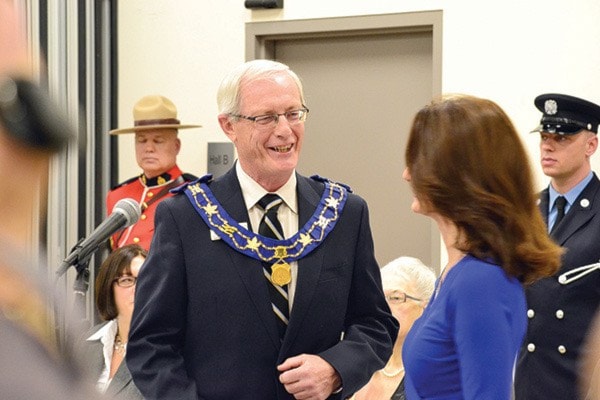The number of in-camera council meetings in White Rock – which has steadily grown over the past five years – is a result of the province enforcing municipal rules, according to Mayor Wayne Baldwin.
In 2015, council met behind closed doors 23 times – and in public 23 times – which marks the most in-camera meetings to have taken place since Baldwin was elected in 2011.
During his inauguration speech in December 2011, Baldwin pledged to end scheduled in-camera meetings, criticizing the number of closed meetings (24) that had taken place the previous year.
Since then, White Rock’s in-camera meetings reduced but have steadily increased in frequency; there were 14 in 2011, 15 in 2012, 18 in 2013 and 20 in 2014. So far this year, council has met seven times in-camera.
Neighbouring City of Surrey has met in-camera five times so far this year, 16 times in 2015 and 18 times in 2014.
Baldwin told Peace Arch News Monday that White Rock’s increase is attributed to the city moving away from holding informal “shirt-sleeve sessions” with council and staff, after the province began “coming down tighter” on the rules surrounding such gatherings.
“Since then, the solicitors and planning staff have been very careful to ensure that if things are done where there’s a quorum present and there’s any process involving decision-making, that it happens either in-camera if it’s appropriate or in the public eye if it’s not appropriate to be in-camera,” Baldwin said.
Asked if the “shirt-sleeve sessions” could be held in open council, Baldwin said the subject matter is often “pretty touchy,” regarding confidential information that can’t be made public.
“It’s hard to say because you’d have to be careful not to say anything that dealt with an individual who could be identified, or a piece of property that could be identified,” he said.
Baldwin noted that starting one year ago, the city began releasing quarterly summations of what was discussed in-camera during the months prior. City clerk Tracey Arthur confirmed two summations were published in 2015, and 2016’s first is expected next week.
Baldwin said he was not aware of the rules surrounding in-camera meetings at the time he was elected in 2011, because following his 2006 retirement from his position as longtime city manager, “I didn’t pay attention to jurisprudence or whatnot.”
“I just knew that there seemed to be an in-camera meeting at pretty well every council meeting, and it didn’t seem appropriate to me, because I remember how difficult it was to go in-camera,” Baldwin said of his 2011 inaugural-speech promise.
Baldwin said he would prefer to have fewer in-camera meetings, but that the city is committed to staying within the provincial laws governing municipalities.
“It’s annoying… but that’s just the way the business is, unfortunately,” he said.
According to the Community Charter, a council meeting is defined as “any gathering to which all members of council have been invited and that is a material part of council’s decision-making process.”
Staff briefings, however, meant to “further council’s understanding of an issue” without any decision-making, would not be considered a meeting of council.
Section 90 of the charter outlines more than a dozen scenarios under which meetings can be closed to the public, including discussions about labour relations, civic security, litigation and personal information about an identifiable potential employee.
